An Exhibition of Roman Wall Paintings from Cremona16 May 2023
 On a class trip to Cremona we had the wonderful opportunity to tour the exhibition Pictura Tacitum Poema. The main highlight was a cubiculum from a domus in Cremona depicting the myth of Ariadne, abandoned on Naxos by Theseus before being discovered by Dionysis. There were also examples of repeating decorative motifs, very similar to wall paintings in Rome and perhaps copied from a book of decorative motifs used by painting workshops. On a class trip to Cremona we had the wonderful opportunity to tour the exhibition Pictura Tacitum Poema. The main highlight was a cubiculum from a domus in Cremona depicting the myth of Ariadne, abandoned on Naxos by Theseus before being discovered by Dionysis. There were also examples of repeating decorative motifs, very similar to wall paintings in Rome and perhaps copied from a book of decorative motifs used by painting workshops.
 The curators and architects of the exhibition designed it in a way to show the process that researchers take to study the fragments of the wall paintings. Similarly to the Museo archeologico "San Lorenzo" (also in Cremona), none of the pieces are fixed permanently to the displays or to each other, which allows them to be rearranged and studied individually: the pieces rest in trays filled with sand, allowing them to be safely cushioned and protected while also being able to be moved around. At the Museo Archaeologico, the fragments of the Nymphaeum are attached to the display by strong magnets for the same reason (see right). The curators and architects of the exhibition designed it in a way to show the process that researchers take to study the fragments of the wall paintings. Similarly to the Museo archeologico "San Lorenzo" (also in Cremona), none of the pieces are fixed permanently to the displays or to each other, which allows them to be rearranged and studied individually: the pieces rest in trays filled with sand, allowing them to be safely cushioned and protected while also being able to be moved around. At the Museo Archaeologico, the fragments of the Nymphaeum are attached to the display by strong magnets for the same reason (see right).
|
Murano island and the Glass Museum16 May 2023
 The history of glassmaking begins four thousand years ago in ancient West Asia, and spread westward though trade with Greece and Rome, eventually leading to Venice's prominence in glass through its maritime trade with the east. This allowed easy access to enough raw materials and glass to fuel a monopoly on the manufacture of European glass unitl the 17th and 18th centuries. Murano's glass industry peaked in the Renaissance period and early 17th century, marked by the recognizabl 3-part goblet style (foot, stem decorated with ribbed orbs or orrnate dragons, and triangular or square cup), which spread to northern Europe. The monopoly of cristallo (clear) glass ended when Bohemia perfected soda glass using raw materials readily available in mainland Europe. This, combined with British trade of cut crystal, effectively ended Venice's glass regime until a stylistic and artistic revival in the 19th century that persists to the present. The history of glassmaking begins four thousand years ago in ancient West Asia, and spread westward though trade with Greece and Rome, eventually leading to Venice's prominence in glass through its maritime trade with the east. This allowed easy access to enough raw materials and glass to fuel a monopoly on the manufacture of European glass unitl the 17th and 18th centuries. Murano's glass industry peaked in the Renaissance period and early 17th century, marked by the recognizabl 3-part goblet style (foot, stem decorated with ribbed orbs or orrnate dragons, and triangular or square cup), which spread to northern Europe. The monopoly of cristallo (clear) glass ended when Bohemia perfected soda glass using raw materials readily available in mainland Europe. This, combined with British trade of cut crystal, effectively ended Venice's glass regime until a stylistic and artistic revival in the 19th century that persists to the present.
|
On the pilgrim path to la Sacra di San Michele3 March 2023
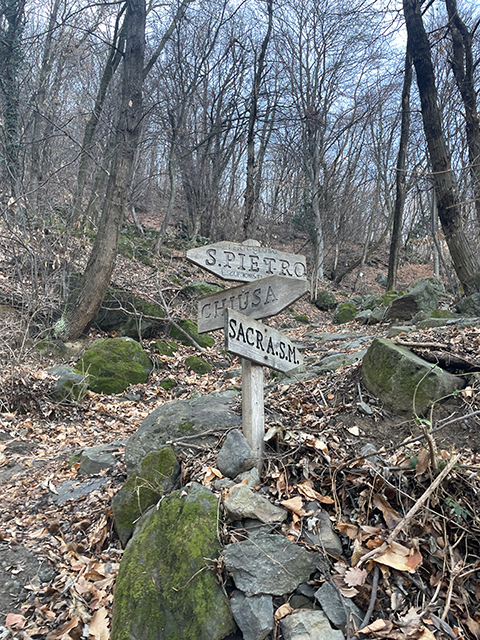 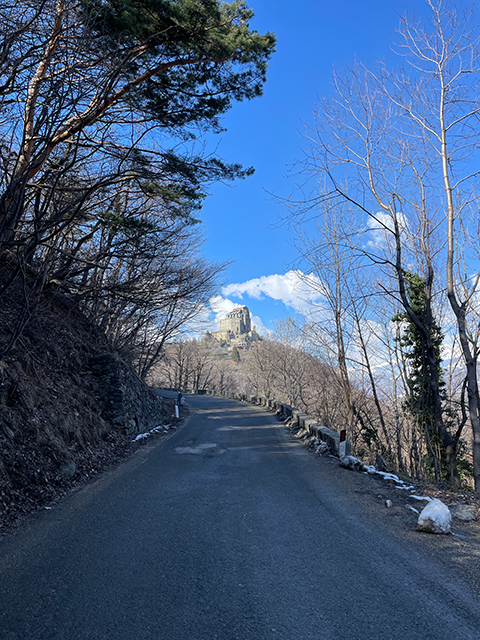 For us to reach the complex of Sacra di San Michele during the week and without a car, we had to take the old pilgrim path from the town of Chiuso San Michele, a two hour long hike that winds up the side of the mountain, 600 m above the starting point. Unbeknownst to us, the paths from San Ambrosio are much more suited to experienced and prepared mountaineers - the few people we saw were decked out in hiking gear and carrying walking sticks. As we got higher, we were able to see more of the val di Susa, which was created by prehistoric glaciers that left plenty of blue-green basalt stone, which was used to pave the path and for much of the construction of the Sacra complex. Photos: trail sign, view of the Sacra from the motorway. For us to reach the complex of Sacra di San Michele during the week and without a car, we had to take the old pilgrim path from the town of Chiuso San Michele, a two hour long hike that winds up the side of the mountain, 600 m above the starting point. Unbeknownst to us, the paths from San Ambrosio are much more suited to experienced and prepared mountaineers - the few people we saw were decked out in hiking gear and carrying walking sticks. As we got higher, we were able to see more of the val di Susa, which was created by prehistoric glaciers that left plenty of blue-green basalt stone, which was used to pave the path and for much of the construction of the Sacra complex. Photos: trail sign, view of the Sacra from the motorway.
 At the Sacra, there is a guesthouse making up the bottom third of the structure, a monastery in the middle, and the church itself resting on the top third. To enter the church, you have to walk up the scala della morte(right), a steep set of stone stairs from which outcroppings of rock from the mountain itself emerge, giving the strange impression that the church grew straight from the earth. Everything is a mixture of Romanesque and Gothic, and construction lasted from the 10th to the 13th centuries. The section of the monastery now in ruins (bottom left) was built as an addition in the 11th century to accomodate the needs of the many monks. The "New Monastery" included cells, a library, kitchen, refectory, and workshops, allowing the Benedictine order to grow. At the Sacra, there is a guesthouse making up the bottom third of the structure, a monastery in the middle, and the church itself resting on the top third. To enter the church, you have to walk up the scala della morte(right), a steep set of stone stairs from which outcroppings of rock from the mountain itself emerge, giving the strange impression that the church grew straight from the earth. Everything is a mixture of Romanesque and Gothic, and construction lasted from the 10th to the 13th centuries. The section of the monastery now in ruins (bottom left) was built as an addition in the 11th century to accomodate the needs of the many monks. The "New Monastery" included cells, a library, kitchen, refectory, and workshops, allowing the Benedictine order to grow.
To leave the Sacra we took the old mule path (bottom center) to Sant'Ambrosio, the same path that was used to bring materials and visitors from the towns on the valley floor to the monastery. At the bottom of the path is the Abbey Palace of Sant'Ambrogio, the 13th century place of defense and justice for the town and the valley.
Finally, this place was the main source of inspiration for Umberto Eco's The Name of the Rose! The only thing missing is the great aedificium.
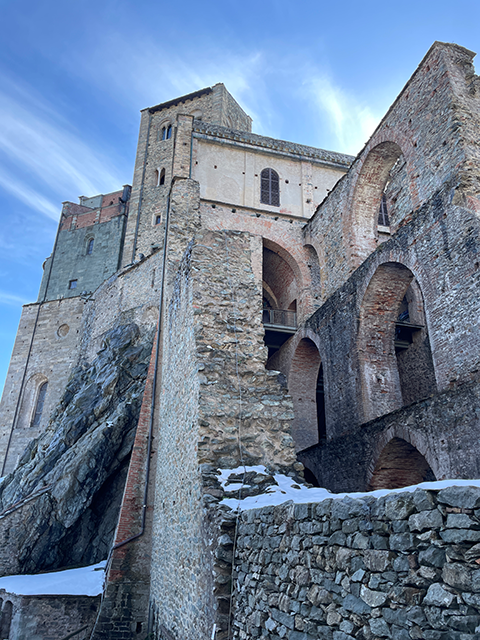

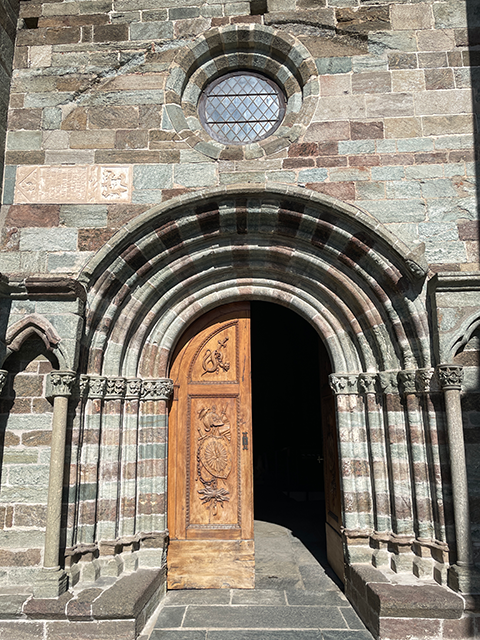

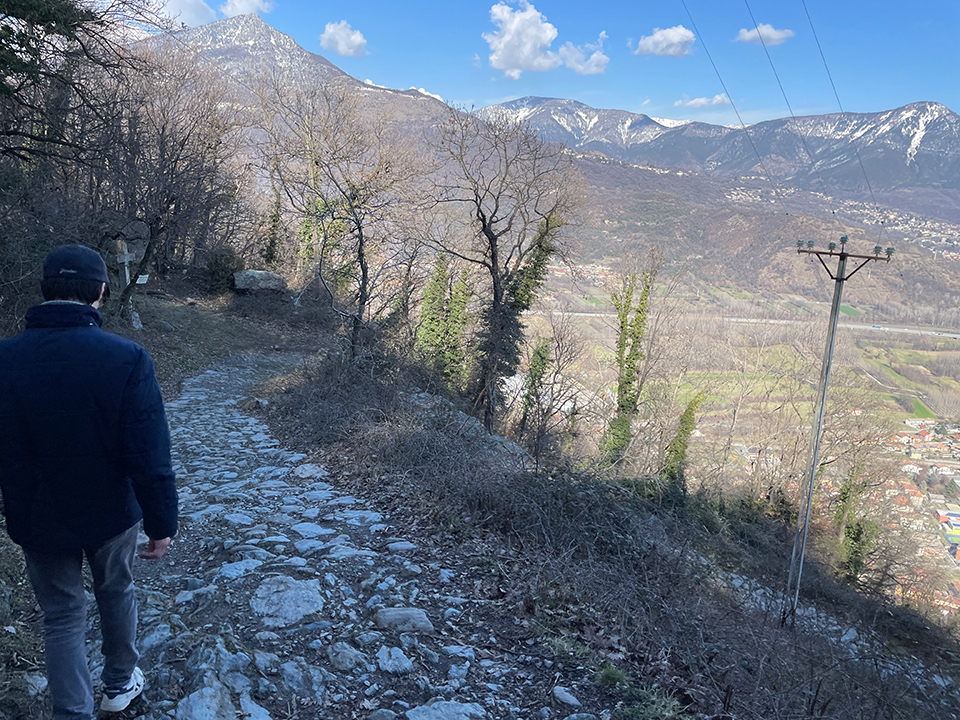
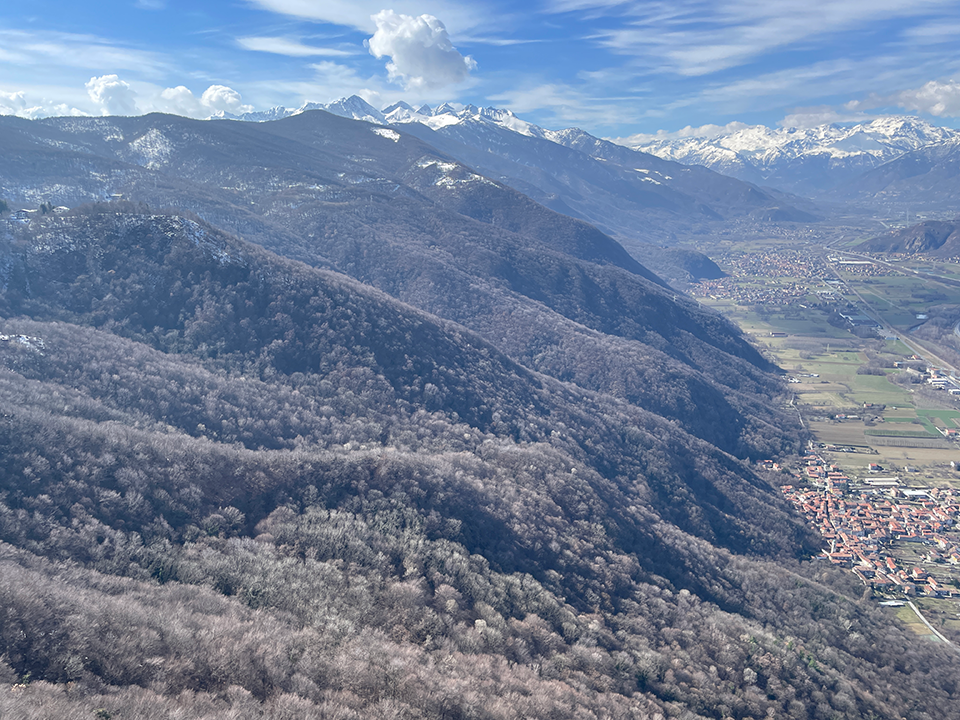
|
A visit to the University of Pavia's Archaeological Museum9 January 2023
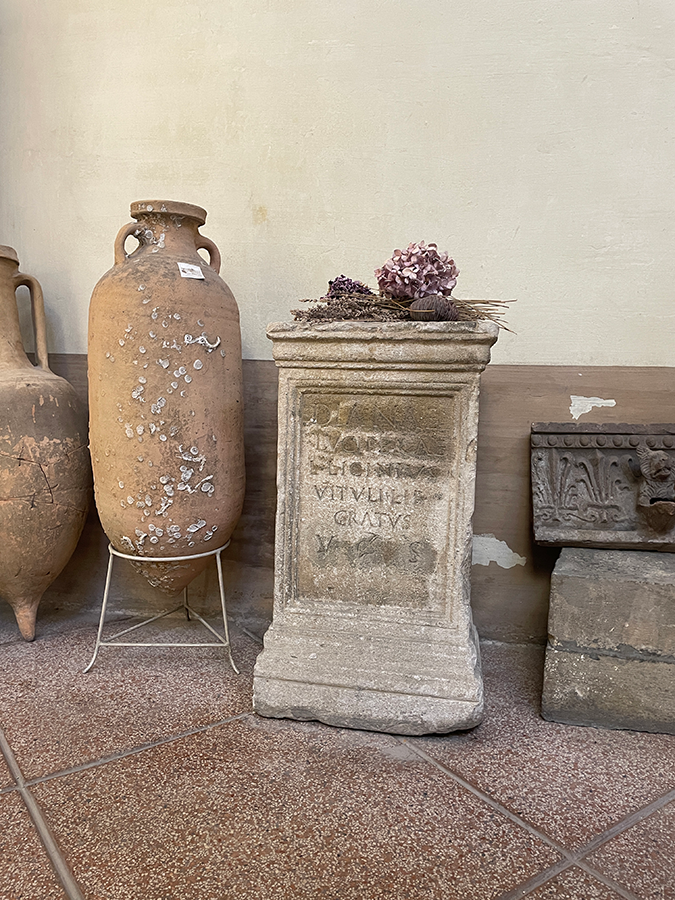 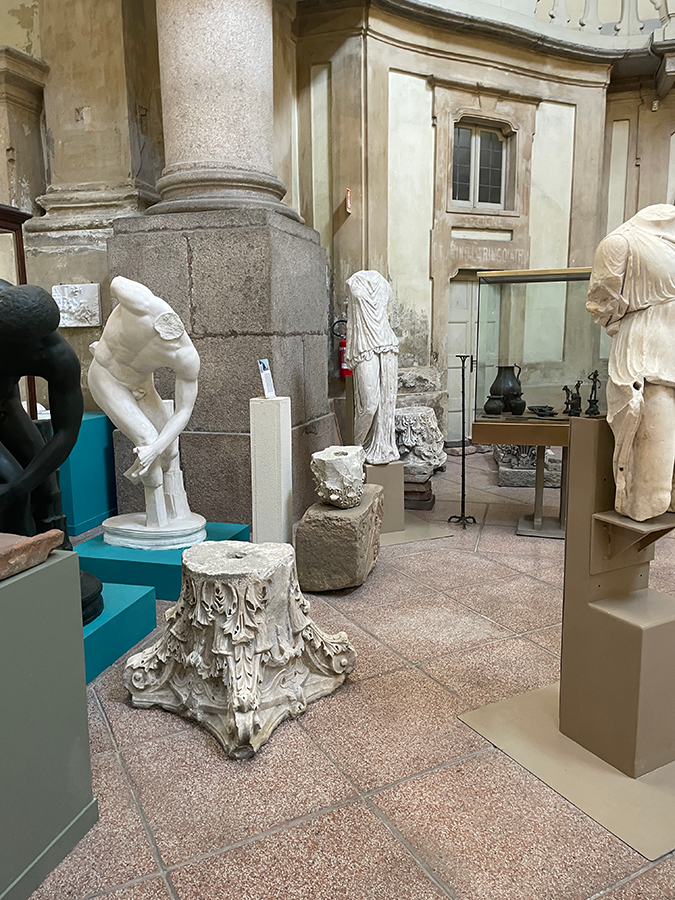 Hidden in a confusing maze of courtyards at the Strada Nuova campus is a quaint collection of archaeological artefacts owned by the University of Pavia that range from iron age Italy to Ptolemaic Egypt to classical statuture, and even includes an actual mummy that was gifted to the university in the 19th century. The museum itself is situated in a single room that used to be a part of a hospital run by the St. Agustine order until the museum was founded in 1819, and the artefacts are loosely organzied in groups throughout the room. Hidden in a confusing maze of courtyards at the Strada Nuova campus is a quaint collection of archaeological artefacts owned by the University of Pavia that range from iron age Italy to Ptolemaic Egypt to classical statuture, and even includes an actual mummy that was gifted to the university in the 19th century. The museum itself is situated in a single room that used to be a part of a hospital run by the St. Agustine order until the museum was founded in 1819, and the artefacts are loosely organzied in groups throughout the room.
The organization of the museum may seem unique or even messy, but it's reminiscent of salon-style exhibitions like the Paris Salon that attracted major artists and critics of the Impressionist movement. Salons and salon gatherings seem to have originated in Italy during the Renaissance and were adopted by intellectuals and elites through the Enlightenment era. I wouldn't be surprised to learn that there were salon gatherings in this museum to discuss the pieces held within, or to learn that the museum is kept in almost the same way today as it was during the past 200 or so years.
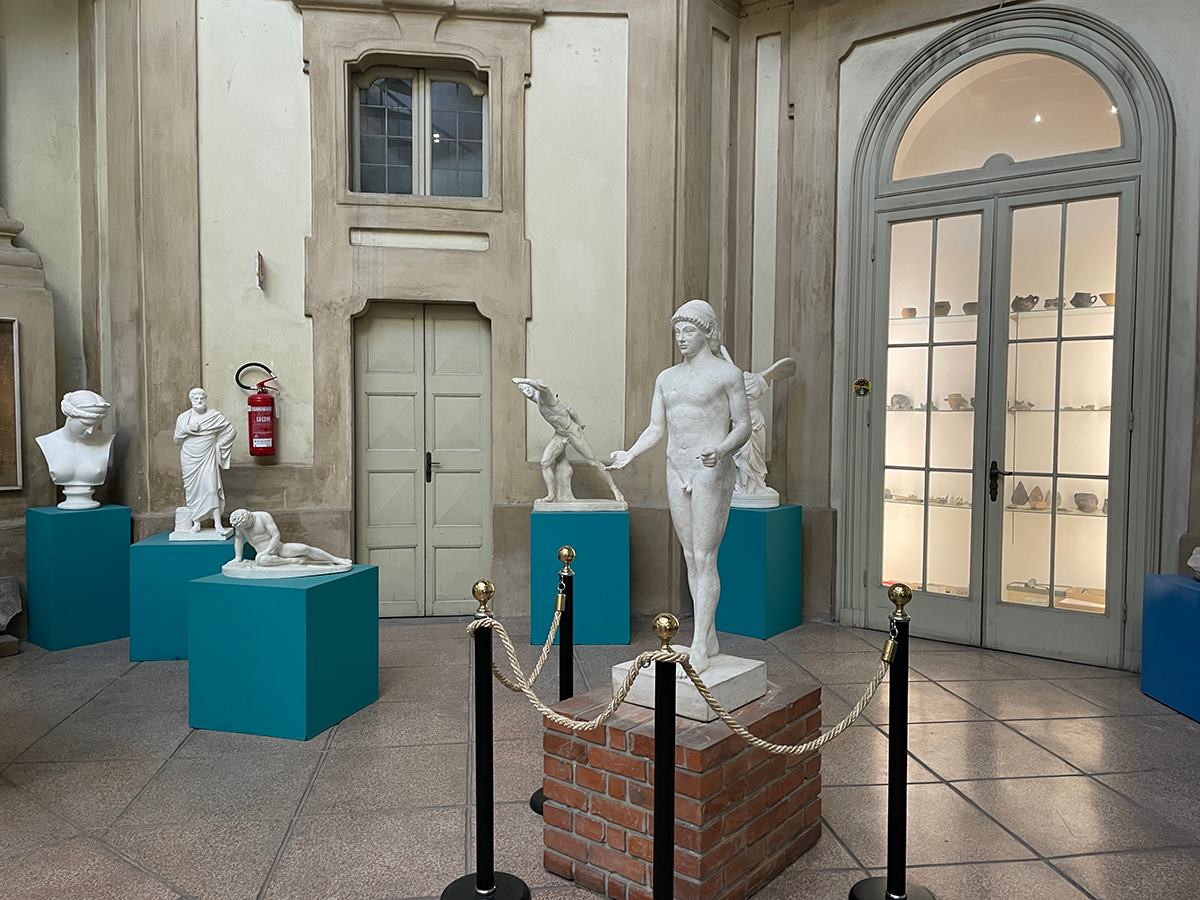
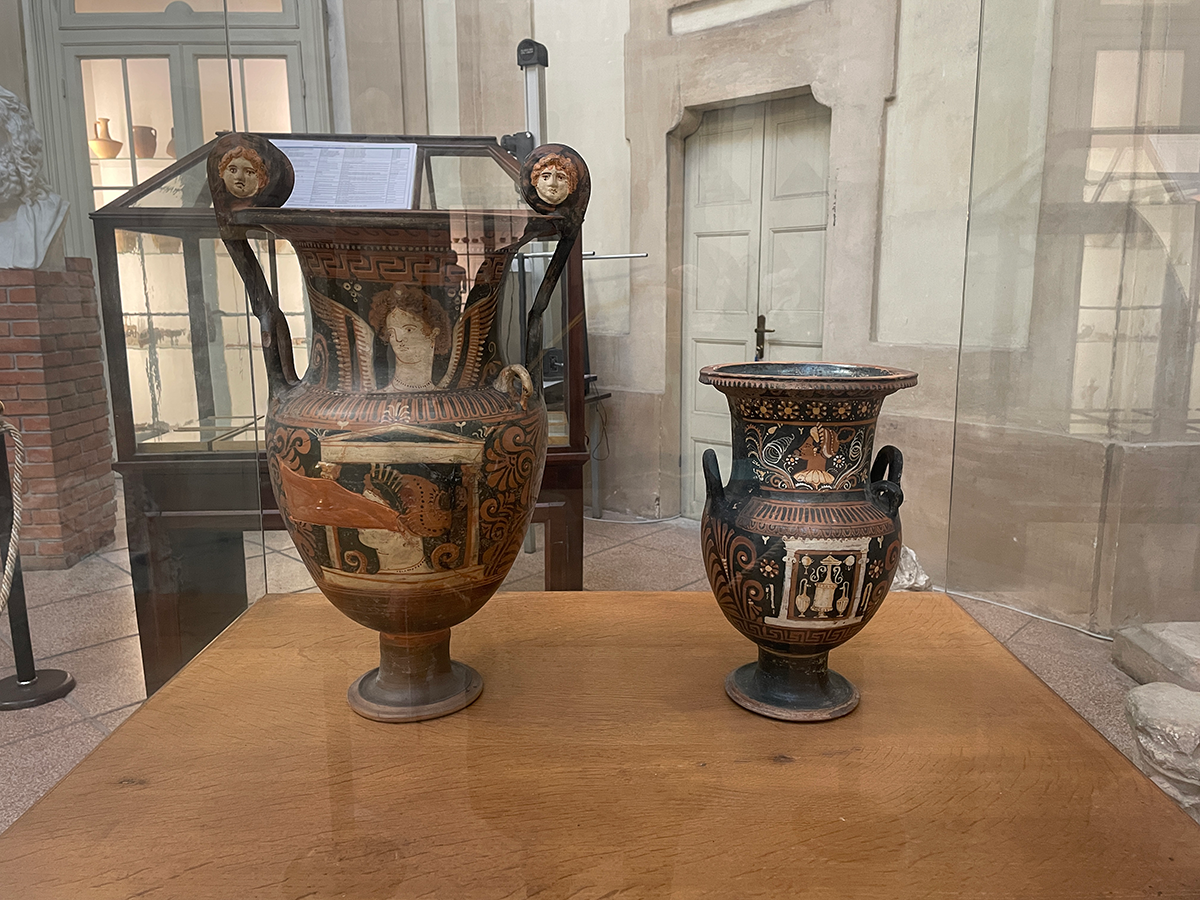
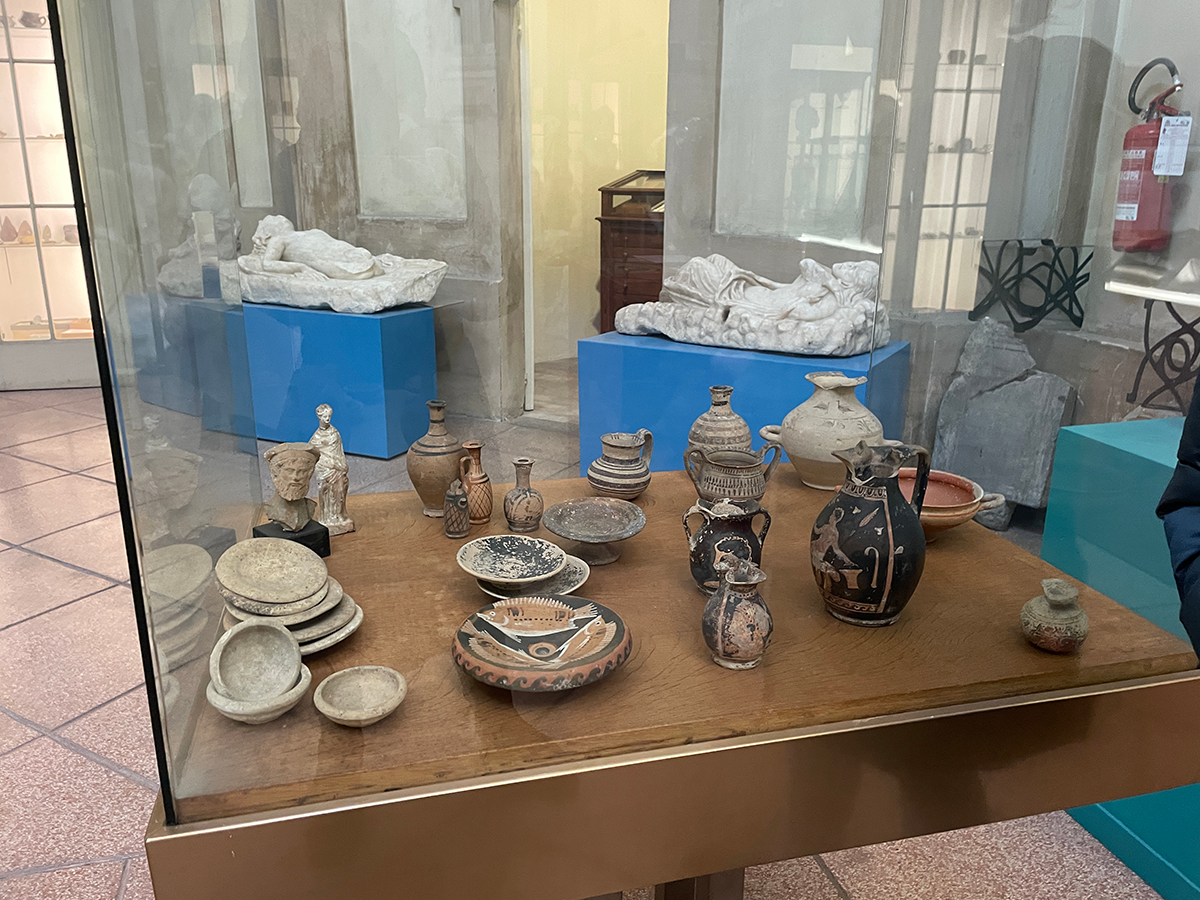
|
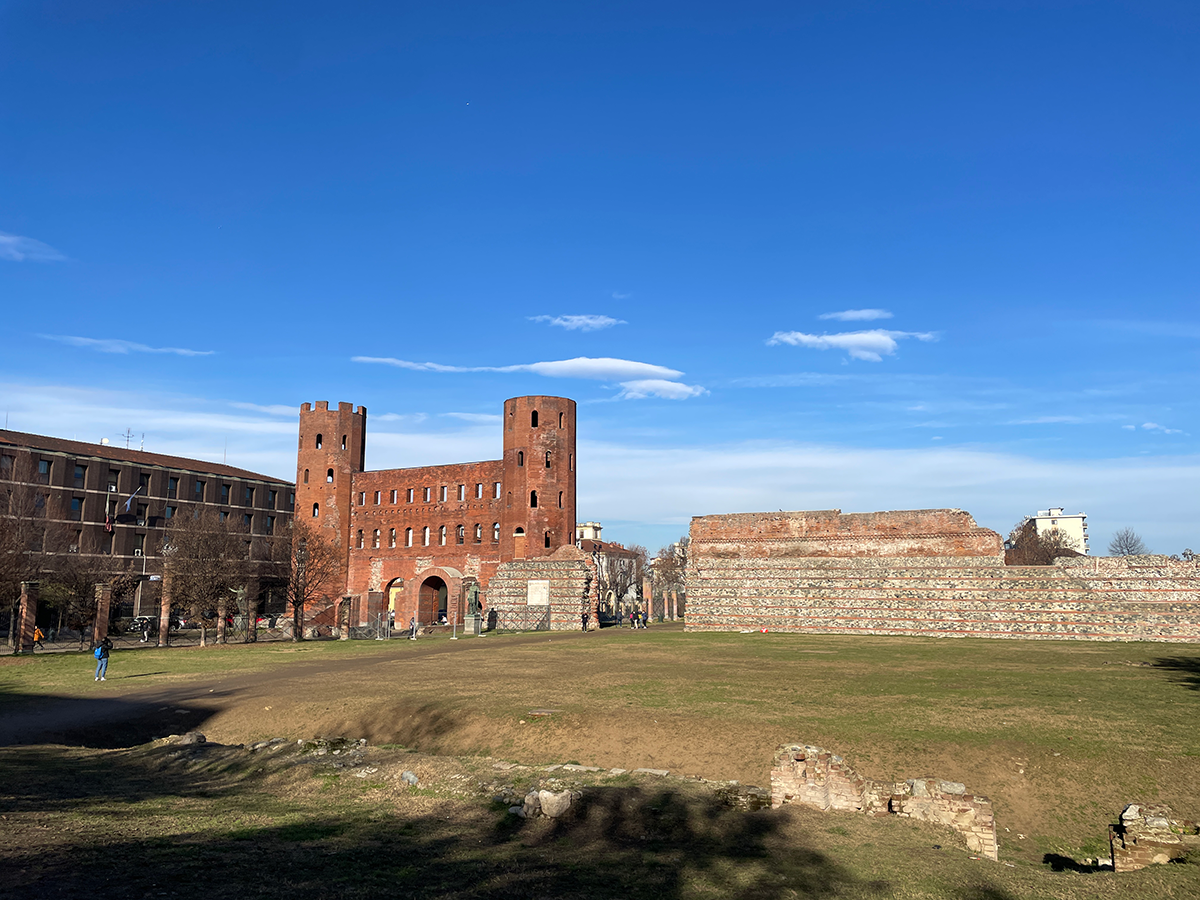 Porta Palatina, Torino5 January 2023
On our trip to Turin, on our way to the Lavazza Museum (post to come?) we passed by The Porta Palatina (Palatine Gate, lit. palace gate). It is a Roman construction from the 1st century BCE and used to be one of the main gates into the Roman-era city Taurinorum which is now Turin. In fact, other Roman constructions can be found in the city like the nearby House of the Senate. The gate didn't lead to an actual palace, and it's unsure why it aquired this name; perhaps it refers to the house of the senate that is nearby or to the Roman ampitheater, or some ruins were confused with a palace by the ancients. In front of the gate is a bronze statue of Julius Ceasar, father of Augustus Ceasar and founder of Taurinorum.
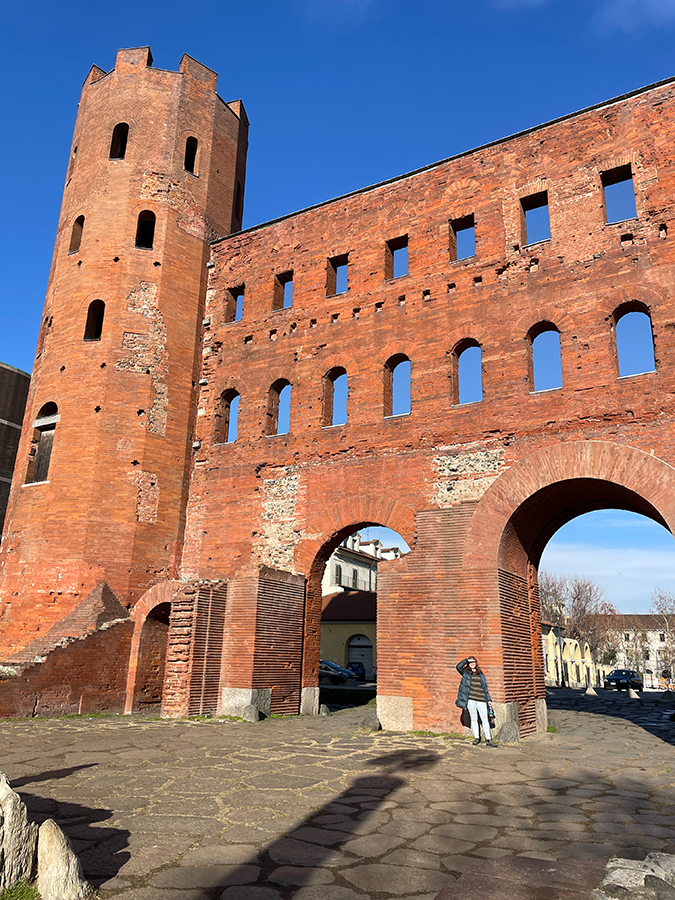
Right: view of the gate from the park, which is on the ex-archaeological site.
Left: close-up of the gate, with my friend Renee for scale. The cobblestone road is also from the same era as the gate, and you can even see the ruts from wagon wheels going through the large arch. The smaller arches were designated for pedestrians and people on horseback.
|

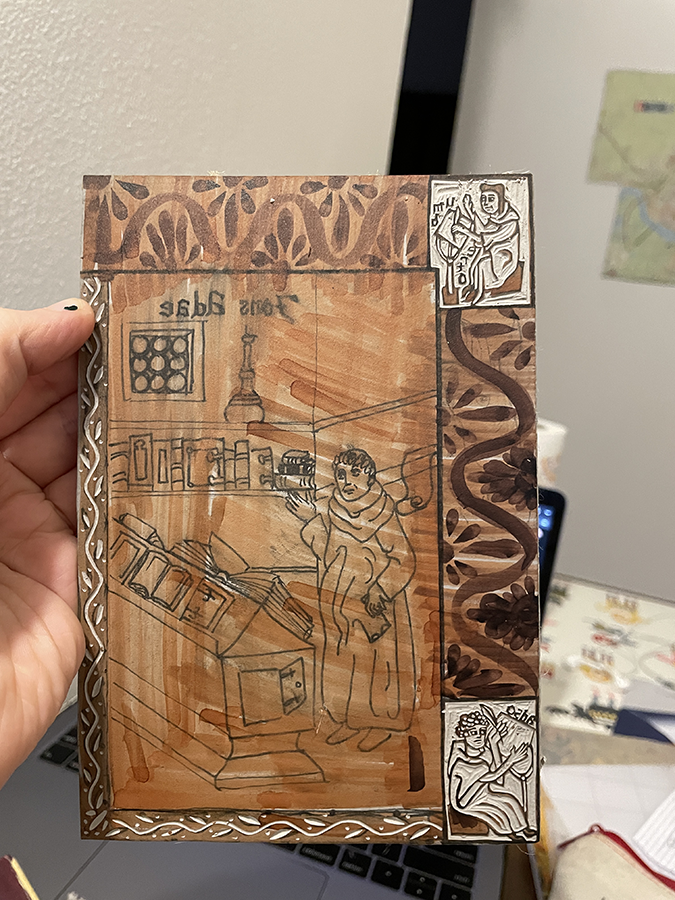 "Woodcut" Medieval ManuscriptDecember 2022
My appreciation for medieval manuscript illumination, woodcut printmaking, and Umberto Eco's The Name of the Rose came together for this project: a linocut in the style of a woodcut manuscript illumination! I wanted to challenge myself with a new style and to be a little more free in my printmaking. For this, the drawing was just of the figure and outlines, so I had to carve all of the shadows freehand as I worked. Usually I plan out every cut because it's hard for me to visualise how values will look in a final print with a medium that only does black and white, but this was good practice for me to learn how values would work as I went. Besides, the style of woodcut and of medieval art in general can be quite forgiving to inaccurate shading or perspectives (which I purposefully made a little wonky). The margin decoration was fun to do as well, but I had to remember to keep it simple because I don't have the ability to use multiple colors like traditional illumination, and I had a very narrow space for the left and bottom margins. For the top and right margins, which are a little larger, I want to do something that will bring together the little margin monks (can you identify them?) and the rest of the piece, and the original plant-like design I have now is too large and simple for the area, but I may use it if I do something like this again). Until I find inspiration, and buy paper, it will remain unfinished.
|
Garden of Earthly Delights Cross-stitch ProjectAS of March 24, 2022, began on Jan 7, 2022
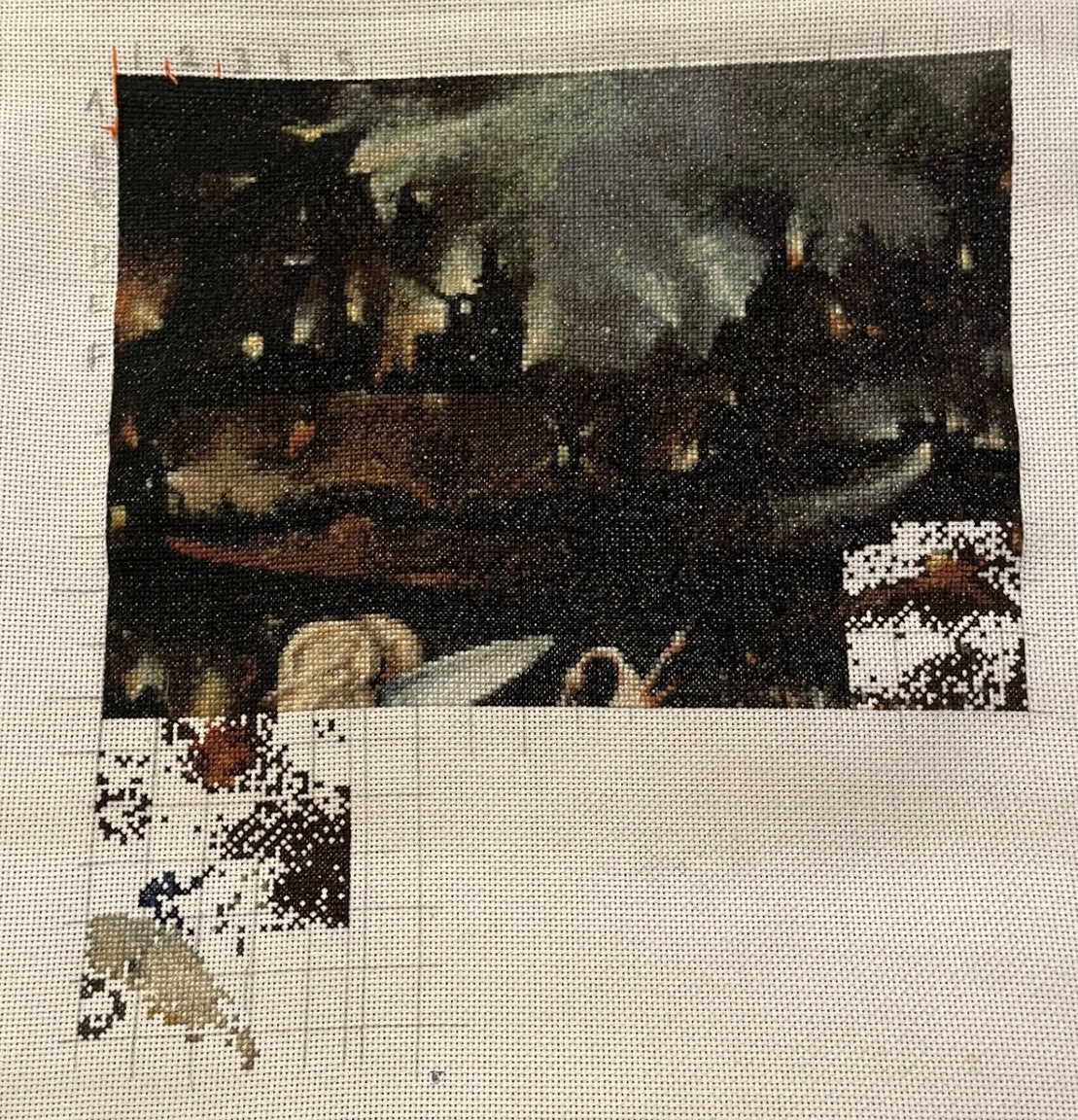
Pattern from xs-collectibles.com.
Finished Size (approximate), 14 count: 12.5” x 30.75”
Stitches: 174w x 430h
|
 On a class trip to Cremona we had the wonderful opportunity to tour the exhibition Pictura Tacitum Poema. The main highlight was a cubiculum from a domus in Cremona depicting the myth of Ariadne, abandoned on Naxos by Theseus before being discovered by Dionysis. There were also examples of repeating decorative motifs, very similar to wall paintings in Rome and perhaps copied from a book of decorative motifs used by painting workshops.
On a class trip to Cremona we had the wonderful opportunity to tour the exhibition Pictura Tacitum Poema. The main highlight was a cubiculum from a domus in Cremona depicting the myth of Ariadne, abandoned on Naxos by Theseus before being discovered by Dionysis. There were also examples of repeating decorative motifs, very similar to wall paintings in Rome and perhaps copied from a book of decorative motifs used by painting workshops. The curators and architects of the exhibition designed it in a way to show the process that researchers take to study the fragments of the wall paintings. Similarly to the Museo archeologico "San Lorenzo" (also in Cremona), none of the pieces are fixed permanently to the displays or to each other, which allows them to be rearranged and studied individually: the pieces rest in trays filled with sand, allowing them to be safely cushioned and protected while also being able to be moved around. At the Museo Archaeologico, the fragments of the Nymphaeum are attached to the display by strong magnets for the same reason (see right).
The curators and architects of the exhibition designed it in a way to show the process that researchers take to study the fragments of the wall paintings. Similarly to the Museo archeologico "San Lorenzo" (also in Cremona), none of the pieces are fixed permanently to the displays or to each other, which allows them to be rearranged and studied individually: the pieces rest in trays filled with sand, allowing them to be safely cushioned and protected while also being able to be moved around. At the Museo Archaeologico, the fragments of the Nymphaeum are attached to the display by strong magnets for the same reason (see right). The history of glassmaking begins four thousand years ago in ancient West Asia, and spread westward though trade with Greece and Rome, eventually leading to Venice's prominence in glass through its maritime trade with the east. This allowed easy access to enough raw materials and glass to fuel a monopoly on the manufacture of European glass unitl the 17th and 18th centuries. Murano's glass industry peaked in the Renaissance period and early 17th century, marked by the recognizabl 3-part goblet style (foot, stem decorated with ribbed orbs or orrnate dragons, and triangular or square cup), which spread to northern Europe. The monopoly of cristallo (clear) glass ended when Bohemia perfected soda glass using raw materials readily available in mainland Europe. This, combined with British trade of cut crystal, effectively ended Venice's glass regime until a stylistic and artistic revival in the 19th century that persists to the present.
The history of glassmaking begins four thousand years ago in ancient West Asia, and spread westward though trade with Greece and Rome, eventually leading to Venice's prominence in glass through its maritime trade with the east. This allowed easy access to enough raw materials and glass to fuel a monopoly on the manufacture of European glass unitl the 17th and 18th centuries. Murano's glass industry peaked in the Renaissance period and early 17th century, marked by the recognizabl 3-part goblet style (foot, stem decorated with ribbed orbs or orrnate dragons, and triangular or square cup), which spread to northern Europe. The monopoly of cristallo (clear) glass ended when Bohemia perfected soda glass using raw materials readily available in mainland Europe. This, combined with British trade of cut crystal, effectively ended Venice's glass regime until a stylistic and artistic revival in the 19th century that persists to the present.
 For us to reach the complex of Sacra di San Michele during the week and without a car, we had to take the old pilgrim path from the town of Chiuso San Michele, a two hour long hike that winds up the side of the mountain, 600 m above the starting point. Unbeknownst to us, the paths from San Ambrosio are much more suited to experienced and prepared mountaineers - the few people we saw were decked out in hiking gear and carrying walking sticks. As we got higher, we were able to see more of the val di Susa, which was created by prehistoric glaciers that left plenty of blue-green basalt stone, which was used to pave the path and for much of the construction of the Sacra complex. Photos: trail sign, view of the Sacra from the motorway.
For us to reach the complex of Sacra di San Michele during the week and without a car, we had to take the old pilgrim path from the town of Chiuso San Michele, a two hour long hike that winds up the side of the mountain, 600 m above the starting point. Unbeknownst to us, the paths from San Ambrosio are much more suited to experienced and prepared mountaineers - the few people we saw were decked out in hiking gear and carrying walking sticks. As we got higher, we were able to see more of the val di Susa, which was created by prehistoric glaciers that left plenty of blue-green basalt stone, which was used to pave the path and for much of the construction of the Sacra complex. Photos: trail sign, view of the Sacra from the motorway. At the Sacra, there is a guesthouse making up the bottom third of the structure, a monastery in the middle, and the church itself resting on the top third. To enter the church, you have to walk up the scala della morte(right), a steep set of stone stairs from which outcroppings of rock from the mountain itself emerge, giving the strange impression that the church grew straight from the earth. Everything is a mixture of Romanesque and Gothic, and construction lasted from the 10th to the 13th centuries. The section of the monastery now in ruins (bottom left) was built as an addition in the 11th century to accomodate the needs of the many monks. The "New Monastery" included cells, a library, kitchen, refectory, and workshops, allowing the Benedictine order to grow.
At the Sacra, there is a guesthouse making up the bottom third of the structure, a monastery in the middle, and the church itself resting on the top third. To enter the church, you have to walk up the scala della morte(right), a steep set of stone stairs from which outcroppings of rock from the mountain itself emerge, giving the strange impression that the church grew straight from the earth. Everything is a mixture of Romanesque and Gothic, and construction lasted from the 10th to the 13th centuries. The section of the monastery now in ruins (bottom left) was built as an addition in the 11th century to accomodate the needs of the many monks. The "New Monastery" included cells, a library, kitchen, refectory, and workshops, allowing the Benedictine order to grow.






 Hidden in a confusing maze of courtyards at the Strada Nuova campus is a quaint collection of archaeological artefacts owned by the University of Pavia that range from iron age Italy to Ptolemaic Egypt to classical statuture, and even includes an actual mummy that was gifted to the university in the 19th century. The museum itself is situated in a single room that used to be a part of a hospital run by the St. Agustine order until the museum was founded in 1819, and the artefacts are loosely organzied in groups throughout the room.
Hidden in a confusing maze of courtyards at the Strada Nuova campus is a quaint collection of archaeological artefacts owned by the University of Pavia that range from iron age Italy to Ptolemaic Egypt to classical statuture, and even includes an actual mummy that was gifted to the university in the 19th century. The museum itself is situated in a single room that used to be a part of a hospital run by the St. Agustine order until the museum was founded in 1819, and the artefacts are loosely organzied in groups throughout the room.






